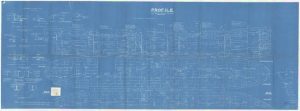The steel steamship Colorado was launched from William Gray’s shipyard in West Hartlepool (Yard No 945) on 23rd August 1923 and taken to their Wearside Yard for completion before being handed over to her owners, the Ellerman Line Ltd of Liverpool. A large cargo passenger steamship she measured 433.0′ x 57.4′ x 30.2′ and her tonnage was gross tonnage of 6614 gross tons, 4228 net tons. She was powered by two steam turbines by Central Marine Engineering Works Ltd., West Hartlepool delivering 787 nominal horse power. Ordered for service on the North Atlantic route she was renamed was renamed as City of Osaka in 1927 and continued to ply these North Atlantic routes under her new name.
In September 1930 the City of Osaka departed from Newcastle on her latest run to New York with a mixed crew of sixty three British, Japanese and Lascar mariners and a cargo of timber under the command of Captain W H Smith. During the night of 22nd they encountered thick fog off the Scottish east coast and in the poor visibility the ship strayed off course. At about 4 am on the 23rd she ran aground in rough seas one mile south of Whinnyfold at Sturdy Point below a 150 foot high cliff. The ship’s wireless SOS messages were picked up by Wick Radio which called out the local lifesaving rocket brigade from Collieston. In the dark, the men made their way carefully along the treacherous cliffs to a position high above the stranded ship. They quickly set up their gear and succeeded in getting a line aboard then started to take the crew off the ship with the British destroyer HMS Walker standing by. Thankfully the transfer ashore of the crew went without a problem and they were soon on their way to shelter in local houses and farms and then by bus to Aberdeen. The final six crewmen, who had stayed aboard the ship, were forced to abandon when she took a substantial list to port and were taken off by the Peterhead lifeboat and brought safely to harbour.
Over the following few days salvage teams arrived on site and removed the cargo and bunker coal hoping to refloat the ship. Initially good weather raised hopes that she could be saved but during the first few days of October a heavy swell from the east worked the ship badly on the rocks and the already damaged hull began to give way and then, on October 8th and 9th, a strong north easterly gale swept through the area and finally condemned the ship as a total wreck. The following week the salvors were instructed to demolish the ship where she lay.
Despite the salvage some wreckage from the City of Osaka survives at the site today in position 57°22.576’N, 001°52.872’W (WGS84) intermingled with the earlier wreckage of SS Nymphaea which stranded in exactly the same location on 14th July, 1914. The broken scattered wreckage lies in 12 metres of water between the shore and the offlying rocks.
We would like to thank Lloyd’s Register Foundation – Heritage & Education Centre for allowing us to reproduce documents from their archive in this article.



































